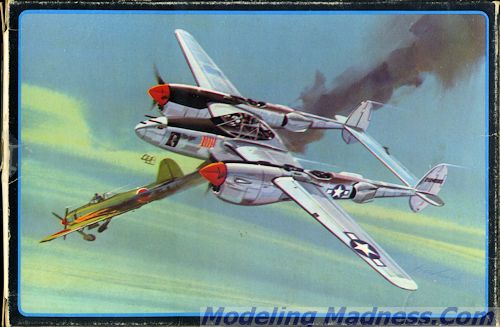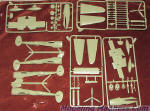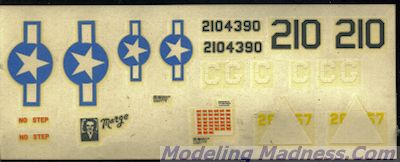
AMT/Frog 1/72 P-38 Lightning
| KIT #: | A-606 |
| PRICE: | 80 cents SRP when new |
| DECALS: | Two options |
| REVIEWER: | Scott Van Aken |
| NOTES: | Frog rebox |

| HISTORY |
The Lockheed P-38 Lightning was a World War II American fighter aircraft built by Lockheed. Developed to a United States Army Air Corps requirement, the P-38 had distinctive twin booms and a single, central nacelle containing the cockpit and armament. The P-38 was used in a number of roles, including dive bombing, level bombing, ground-attack, night fighting, photo reconnaissance missions, and extensively as a long-range escort fighter when equipped with drop tanks under its wings.
The P-38 was used most successfully in the Pacific Theater of Operations and the China-Burma-India Theater of Operations as the mount of America's top aces, Richard Bong (40 victories) and Thomas McGuire (38 victories). In the South West Pacific theater, the P-38 was the primary long-range fighter of United States Army Air Forces until the appearance of large numbers of P-51D Mustangs toward the end of the war.
The P-38 was unusually quiet for a fighter, the exhaust muffled by the turbo-superchargers. It was extremely forgiving, and could be mishandled in many ways, but the rate of roll in the early versions was too slow for it to excel as a dogfighter. The P-38 was the only American fighter aircraft in production throughout American involvement in the war, from Pearl Harbor to Victory over Japan Day.
| THE KIT |
 Frog
as a model company went out of business in 1976 with its molds being distributed
to either Revell AG or to the then Soviet Union, often marketed by Novo. While
they were still around, AMT imported them and provided their own boxes and
instructions. These kits are still being produced today and can frequently be
found in new boxes from a variety of sources. Considered to be the first
injected plastic kits, Frog helped to set the standards for kits as we know them
today.
Frog
as a model company went out of business in 1976 with its molds being distributed
to either Revell AG or to the then Soviet Union, often marketed by Novo. While
they were still around, AMT imported them and provided their own boxes and
instructions. These kits are still being produced today and can frequently be
found in new boxes from a variety of sources. Considered to be the first
injected plastic kits, Frog helped to set the standards for kits as we know them
today.
Apparently there are only a given number of ways to mold a P-38 and this kit follows what is pretty much a standard breakdown of parts. The cockpit consists of little more than a seat and pilot figure, the norm for the time. There are two main fuselage halves with a separate nose section. The nose guns are all individual rods and fit into triangular cut-outs in the nose. There is a lot of room for weight and you'll need it. The wheel wells are not boxed in and the design of the main gear is such that they need to be installed as the halves are closed. The wheels are very toy-like with no detail.
This goes for the boom bear wells as well. Wings are in six sections. The outer sections are upper and lower while the center section includes long, flat wing spars. This means it needs to be installed before the outer wing panels. There is a long slot in the fuselage pod that slips into the wings. The tail plane is a long inner section with two short outer sections. On the booms there is a cap for the front onto which is attached a prop and spinner. The boom coolant radiators are molded flat on the front and rear. Atop the booms are the two supercharger intakes as well as two separate, small, intakes. There are drop tanks for the inner wing sections and rocket racks for the outer wings. I like that the holes for these items have not been pre-opened so you can build the kit unencumbered. A one-piece canopy with very faint frame lines tops all of this.
 Instructions
are basically an exploded view with 13 written construction steps, something
those used to kits of the 60's will find familiar. The now-shot decals include
one for Dick Bong as shown on the box art and a ca
Instructions
are basically an exploded view with 13 written construction steps, something
those used to kits of the 60's will find familiar. The now-shot decals include
one for Dick Bong as shown on the box art and a ca mouflaged
plane from an unspecified European theater unit. The kit can allegedly be built
as either a P-38J or P-38L, however, the raised detailing under the wing has the
compressability flaps so those will need to be removed for a J.
mouflaged
plane from an unspecified European theater unit. The kit can allegedly be built
as either a P-38J or P-38L, however, the raised detailing under the wing has the
compressability flaps so those will need to be removed for a J.
| CONCLUSIONS |
Kits like this are truly easy to find from vendors at just about any model show or swap meet and usually for a pittance. If you are seriously on a budget, want a nostalgia build or just want something that is relatively quick and easy to build, then these old Frog kits, regardless of what box they are in, are just the ticket.
| REFERENCES |
http://en.wikipedia.org/wiki/Lockheed_P-38_Lightning
October 2014 If you would like your product reviewed fairly and fairly quickly, please contact the editor or see other details in the
Note to
Contributors.